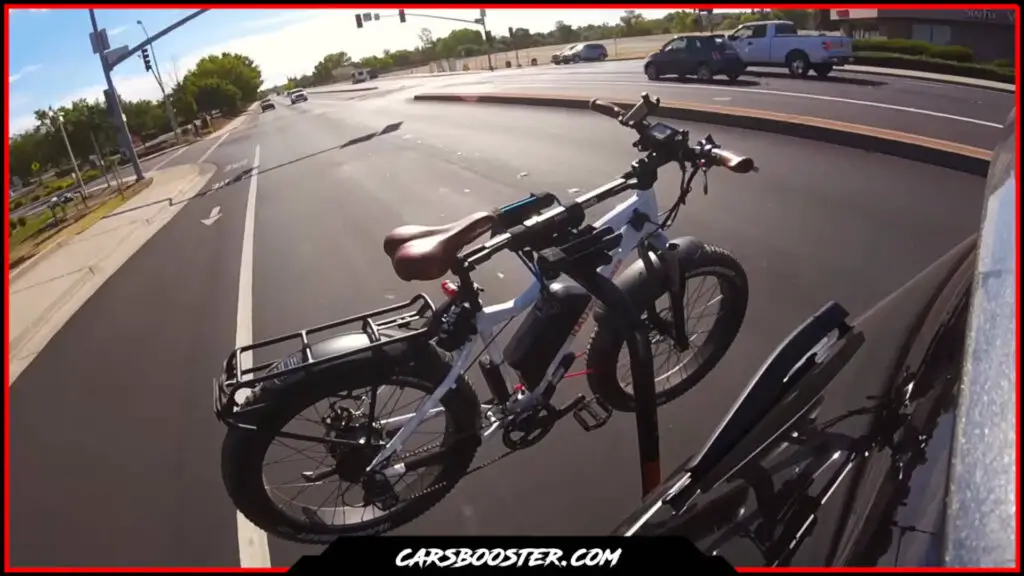
If you enjoy riding, moving your bike from one place to another might be difficult, especially if you have to go a long way. By giving you a safe and secure means to carry your bike, bike racks are a great answer to this problem. However, one common issue that bike enthusiasts face is the swaying of the bike rack during transportation. This can be dangerous and potentially damage your bike, so it’s essential to learn how to keep bike rack from swaying.
In this blog post, we will discuss some practical tips on how to keep your bike rack from swaying, ensuring both your bike’s and others’ safety on the road.
In short: At the end of this article, you will have all the essential information and tricks that can help you prevent your bike rack from swaying.
Why Does The Bike Rack Sway?
First, in order to have an anti sway bike rack, first we need to know and understand why bike racks sway.
Overloading
One of the most common reasons why bike racks sway is overloading. It will put too much weight on the rack and make it sway if you’re hauling more bikes than the bike rack is intended to support. This is risky since the extra weight might reduce your car’s stability and raise the possibility of an accident.
To prevent overloading, make sure you know the weight limit of your bike rack and stick to it. Consider upgrading to a bigger, more durable rack if you need to transport more bikes than your current rack can support.
Poor Installation
Another common cause of bike rack swaying is poor installation. If your rack isn’t installed properly or securely, it can shift and move while you’re driving, causing the bikes to sway back and forth.
Before you get on the road, double-check that all the nuts and screws are tightened according to the manufacturer’s recommendations while installing your bike rack.
You can also consider using additional straps or tie-downs to secure your bike rack even further.
Wind Resistance
Even if your bike rack is properly installed and not overloaded, it can still sway due to wind resistance. If you’re traveling at a fast pace or in a windy environment, this is especially true.
Improper Hitch Fit
If your bike rack is attached to your vehicle via a hitch, an improper hitch fit can also cause swaying. If the hitch is loose, the bike rack can move around and sway while you’re driving.
To prevent this, make sure to use the correct hitch size for your bike rack and vehicle and ensure it’s properly secured and tightened before hitting the road.
Road Conditions
Another factor that can cause bike racks to sway is road conditions. If you’re driving on a bumpy or uneven road, your bike rack can bounce around and sway.
If you want to lessen the effect of jolts and bumps, you may also think about installing a bike rack that absorbs shock or cushioning the frame of your bike.
Center of Gravity
The center of gravity of your bike rack can also affect how much it sways. If your bikes are positioned too high or too far back on the rack, it can increase the swaying motion.
Suspension
If your vehicle has a soft suspension, it can also contribute to bike rack swaying. This is because the suspension can compress and rebound, causing the bike rack to bounce around.
To prevent this, consider upgrading your vehicle’s suspension or using a bike rack with a suspension system built-in.
You can also consider using a anti sway bar for bike rack or weight distribution hitch to help reduce the swaying motion.
Maintenance
Finally, proper maintenance is key to preventing bike rack swaying. Regularly check your bike rack for indications of wear and tear, and replace any broken or worn-out components immediately.
Moreover, be sure to routinely clean your bike rack to get rid of any dirt or debris that can impair its functionality.
After we have completely understood all the reasons that cause a bike rack to sway, now it’s time to know how to keep bikes from swaying on bike racks.
How To Prevent Bike Rack From Swaying On The Highway?
Check for Proper Installation
The first step in preventing sway is ensuring proper installation. When installing your bike rack, follow the manufacturer’s instructions to the letter.
Double-check that all bolts and screws are tightly fastened, and ensure that your hitch is compatible with your bike rack. If your hitch is loose or not properly attached, your bike rack will sway, and your bike may fall off. Remember, a poorly installed bike rack is a recipe for disaster.
Additionally, inspect your bike rack before each use. Look for signs of wear and tear or broken parts that cause sway, if you notice any damage, replace the affected parts before using the bike rack. If you don’t, you risk suffering major injuries or damaging your bike.
Make sure that your bike rack is the correct size for your vehicle. A bike rack that is too small or too large for your car model can cause sway, and your bike may slip off the rack.
Use Stabilizing Straps
Stabilizing straps are an excellent way to keep your bike rack from swaying. These straps secure your bike rack to your vehicle’s trunk, roof, or rear hatch, preventing it from moving back and forth. Stabilizing straps come in different sizes and lengths, so make sure you choose the ones for your bike rack and vehicle.
When using stabilizing straps, ensure that tight and secure. Loose straps will not prevent sway, and your bike rack may still wobble.
Furthermore, make sure that the straps do not interfere with’s taillights or license plate. Doing so can result in a ticket or an accident.
When using stabilizing straps, avoid over-tightening them. Over-tightening can damage your bike rack, your vehicle, or your bike. Follow the manufacturer’s instructions to ensure proper usage.
Adjust the Tension
Another way to prevent bike rack sway is to adjust the tension. Most bike racks come with a tension knob or lever that allows you to adjust the rack’s tightness. When tightening the knob or lever, ensure that the bike rack is snug against your vehicle. This will prevent the bike rack from moving back and forth, causing sway.
When adjusting the tension, avoid overtightening your bike rack. Over-tightening can damage your bike frame or the bike rack itself. Remember, you want your bike rack to be secure, but not so tight that it causes damage.
Always test the tension before hitting the road. Give the bike rack a slight shake to see if it moves. If it does, adjust the tension until you achieve a secure fit.
Ensure Proper Weight Distribution
Proper weight distribution is critical in preventing bike rack sway. When loading your bike, ensure that the weight is evenly distributed on the bike rack. If your bike is too heavy on one side, it can cause the bike rack to sway.
Additionally, ensure that your bike is properly secured to the bike rack. Use straps or bungee cords to secure your bike to the bike rack, preventing it from moving back and forth.
A loose bike can cause sway, even if the bike rack is tightly attached to your vehicle. Avoid carrying too much weight on your bike rack. Overloading your bike rack can cause sway and damage to your bike rack or vehicle.
Reduce Wind Resistance
Wind resistance can cause bike rack sway, especially when driving at high speeds. Reduce wind resistance by removing any accessories or items that may cause drag, such as bike bags, water bottles, or bike pumps. These items can create turbulence and cause the bike rack to sway.
Additionally, consider using a fairing, which is a device that attaches to the roof-mounted bike rack and reduces wind resistance. A fairing can significantly reduce bike rack swaying and provide a more stable ride.
Use Anti-Sway Devices
Another way to prevent bike rack sway is by using anti-sway devices. These devices attach to your bike frame or the bike rack itself, preventing the bike from moving back and forth.
Anti-sway devices come in different shapes and sizes, so ensure that you choose the ones that fit your bike and bike rack.
When using anti-sway devices, ensure that they are properly installed and secured. Loose devices will not prevent sway and can cause damage to your bike. Additionally, avoid using too many anti-sway devices, as this can cause bike rack overload and sway.
Check and Tighten Bolts and Screws Regularly
Regular maintenance is essential in preventing bike rack sway. Check your bike rack bolts and screws regularly to ensure that they are tight and secure. Loose bolts and screws can cause sway, even if your bike rack is properly installed.
Additionally, inspect your bike rack for signs of wear and tear, corrosion, or rust. If you notice any damage, replace the affected parts immediately. Failure to do so can cause the bike rack to sway, and your bike may fall off the rack.
Lubricate your bike rack hinges, joints, and moving parts regularly. Doing so rust and corrosion, ensuring a longer lifespan for your bike rack.
Use a Hitch Lock
Using a hitch lock is another way to prevent bike rack sway. A hitch lock secures your bike rack to your vehicle’s hitch, preventing thieves from stealing your bike rack. Additionally, a hitch lock can prevent sway by ensuring that your bike rack is tightly attached to your vehicle.
When using a hitch lock, ensure that it is compatible with your bike rack and vehicle. Additionally, follow the manufacturer’s instructions to ensure proper usage.
Consider a Sturdier Bike Rack
If all else fails, consider investing in a sturdier bike rack. A high-quality bike rack can prevent sway and ensure the safety of your bike and other vehicles on the road. Look for a bike rack that is compatible with your vehicle and can withstand the weight of your bike.
When choosing a bike rack, consider the materials used, the weight limit, and the design. Additionally, read reviews and ask for recommendations from fellow cyclists to ensure that you choose a reliable and sturdy bike rack.
Drive Carefully
Finally, it is essential to drive carefully when transporting your bike. Avoid sudden stops or starts, and take turns slowly and carefully. Be aware of your surroundings and avoid driving in windy conditions or on rough roads.
Driving carefully can prevent bike rack swaying and ensure that you and your bike arrive safely at your destination.
Conclusion: How to Stop Bike Rack From Swaying?
Preventing bike rack sway is essential in ensuring the safety of your bike and other vehicles on the road. By following these practical tips, you can prevent sway and enjoy a safe and comfortable ride.
Remember always to inspect your bike rack before each use, use stabilizing straps and anti-sway devices, ensure proper weight distribution, and maintain your bike rack regularly.
Additionally, consider investing in a high-quality and sturdy bike rack to ensure a safe and enjoyable ride for years to come.



